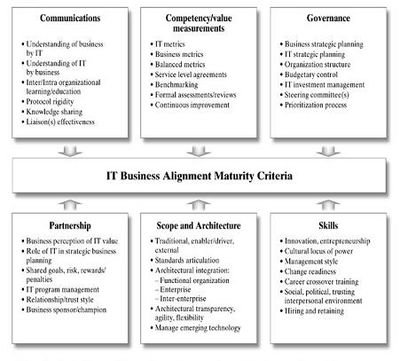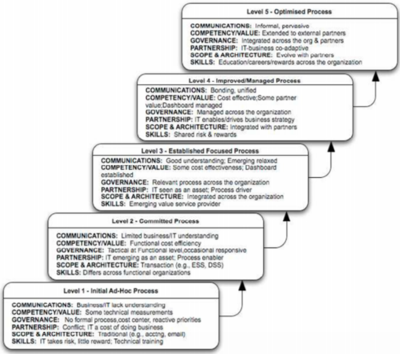Strategic Alignment Maturity Model
Strategic Alignment Maturity Model (SAMM) is a tool that can be used to measure alignment maturity. SAMM proposes that IT-Business alignment can be captured according to six areas of maturity. It also shows some sample attributes of each area relevant to the measurement. SAMM prescribes the following areas to measure organizational maturity:
A) Communication;
B) Competency/Value measurement;
C) Governance;
D) Partnership;
E) Scope and architecture; and
F) Skills.
For each of these areas, this maturity model classifies the alignment between business and IT into five levels:
- 1) Initial / Ad hoc process;
- 2) Committed process;
- 3) Established / Focused process;
- 4) Improved / Managed process;
- 5) Optimized process.[1]
Luftman developed a maturity assessment model based on the 12 elements of Business/IT-Alignment, which can be recognized in the model of Henderson and Venkatraman. The components of this model, in concert with the earlier, enables/inhibitors research (Luftman and Brier, 1999), form the building blocks for the strategic alignment maturity assessment method (Luftman, 2000).
This model can be used in a survey to see where a company stands regarding maturity. Once this maturity is understood, it can provide the organization with a roadmap that identifies opportunities for enhancing the harmonious relationship between business and IT (Luftman, 2000). The model consists of 6 alignment areas ( See Figure 1.). Each area has multiple attributes. For each area, there are clearly defined maturity levels. All areas should be given attention to mature the alignment between business and IT. [2]

Figure 1. source: Business/IT-Alignment
Luftman(1999) indicated that there are six criteria that organizations can check to measure the level of alignment between IT and Business; these criteria are:
- Communications Maturity
- Competency/Value Measurement Maturity
- Governance Maturity
- Partnership Maturity
- Scope & Architecture Maturity
- Skills Maturity [3]
Strategic Alignment Maturity Model Alignment Levels[4]
The alignment maturity level of an organization is determined by the management practices and strategic IT decisions within an organization based on the above six alignment maturity factors. Level one is the lowest maturity alignment level, and level five is the highest maturity level. The five possible alignment maturity levels shown in Figure 2 are defined below:
Level 1: Initial or Ad Hoc Process: Business and ICT are not aligned or harmonized.
Level 2: Committed Process: The organization has committed to becoming aligned.
Level 3: Established Focused Process: Strategic Alignment Maturity is established and focused on business objectives. There are established processes (such as a systems steering committee) and activities (such as portfolio management capabilities to evaluate IT investments) to realize strategic alignment.
Level 4: Improved or Managed Process: ICT has been reinforced as a value center. ICT applications are leveraged across the enterprise to drive process enhancements that sustain competitive advantage.
Level 5: Optimized Process: The organization has integrated business and ICT strategic planning.

Figure 2. source: IISTE.Org
See Also
References
Further Reading
- The Impact of Strategic Alignment Maturity of Business and Information Technology on Performance: Case Study of Jordan Public Sector Organizations
- Strategic Alignment Maturity - Managing the Information Technology Resource
- An Evolution of IT-Business Strategic Alignment Maturity at Ciba Speciality Chemicals
- THE STRATEGIC ALIGNMENT MATURITY OF BUSINESS AND INFORMATION TECHNOLOGY AT VOLKSWAGEN SOUTH AFRICA
